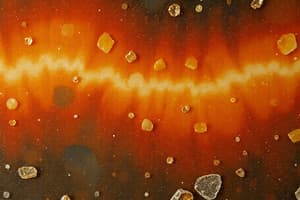Podcast
Questions and Answers
What does luster refer to?
What does luster refer to?
- The shape of a mineral
- The color of a mineral
- The texture of a mineral
- How light is reflected from the surface of a mineral (correct)
What are the two main types of luster?
What are the two main types of luster?
Metallic and nonmetallic
Name the types of nonmetallic luster.
Name the types of nonmetallic luster.
Vitreous, resinous, pearly, greasy, silky, adamantine, dull
What is vitreous luster?
What is vitreous luster?
What does resinous luster refer to?
What does resinous luster refer to?
What is pearly luster?
What is pearly luster?
What does greasy luster look like?
What does greasy luster look like?
What is silky luster?
What is silky luster?
What does adamantine luster mean?
What does adamantine luster mean?
What is dull luster?
What is dull luster?
What characterizes metallic luster?
What characterizes metallic luster?
Flashcards
Luster
Luster
How light is reflected from the surface of a mineral
Types of Luster
Types of Luster
The main categories of luster; metallic and nonmetallic
Nonmetallic Luster Types
Nonmetallic Luster Types
Vitreous, resinous, pearly, greasy, silky, adamantine, dull
Vitreous Luster
Vitreous Luster
Signup and view all the flashcards
Resinous Luster
Resinous Luster
Signup and view all the flashcards
Pearly Luster
Pearly Luster
Signup and view all the flashcards
Greasy Luster
Greasy Luster
Signup and view all the flashcards
Silky Luster
Silky Luster
Signup and view all the flashcards
Adamantine Luster
Adamantine Luster
Signup and view all the flashcards
Dull Luster
Dull Luster
Signup and view all the flashcards
Metallic Luster
Metallic Luster
Signup and view all the flashcards
Study Notes
Luster Overview
- Luster indicates how light interacts with the surface of a mineral.
- Two primary categories exist: metallic and nonmetallic luster.
Types of Nonmetallic Luster
- Vitreous: Resembles the sheen of glass, associated with minerals that reflect light similarly.
- Resinous: Exhibits a luster similar to resin; exemplified by sphalerite.
- Pearly: Mimics the iridescence of pearls, recognizable on cleavage faces of minerals with perfect cleavage.
- Greasy: Appears as though coated in a light film of oil, contributing to a unique visual characteristic.
- Silky: Reflects the smooth sheen of silk, typically found in minerals with fine parallel fibers like chrysotile asbestos. An example is gypsum.
- Adamantine: Characterized by the hard, sparkling appearance akin to diamonds, noted for high brilliance.
- Dull: Displays a non-reflective surface that lacks metallic qualities, presenting a plain appearance.
Metallic Luster
- Metallic: Conveys the appearance of polished metal, giving minerals a shiny and reflective quality.
Studying That Suits You
Use AI to generate personalized quizzes and flashcards to suit your learning preferences.




